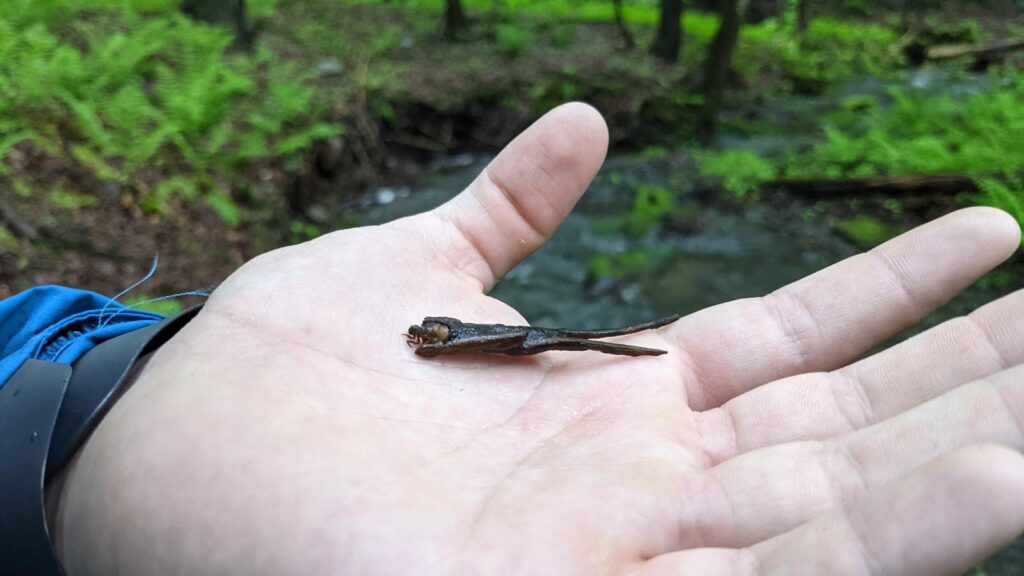Ecosystem engineers are species that change the habitats in which they live. In the Trust’s program area, one ecosystem engineer that many would first think of is a beaver. However, there is another ecosystem engineer in our waters that is changing the way our streams and rivers flow: the Caddisfly.
While small, these small insects are incredibly important in their systems. Caddisflies are sensitive to pollution and other environmental changes, and by assessing their presence, stream scientists are able to get a good understanding of a stream’s health. If caddisflies are present and disappear, that may indicate stream conditions have changed enough to a point where caddisflies cannot live there anymore. Alternatively, if caddisflies have not historically been in a stream and appear, that could point to positive changes in a stream’s quality.
Perhaps one of the most important steps to using caddisflies to assess stream quality is knowing how to identify them. With many different types of aquatic insects living in our streams, being able to distinguish a caddisfly from another species ensures that we can be fully sure that we understand the communities in our waters.
Caddisflies have life stages in both the water and on land, but for our purposes we’ll be focusing on the aquatic stage of their life when they are larvae. To identify if an insect is a caddisfly, first look at the shape of its body. These macroinvertebrates, or animals without backbones, have long bodies that are usually smaller than 45 millimeters or about the size of a paperclip. Their heads have hard skin compared to the rest of their bodies and no antennae. They have 3 pairs (or 6 total) legs extending from their middle body segment which is called the thorax. Their abdomen, which is the segment farthest from the head, will be soft and fleshy with branched gills. The most notable feature of many caddisflies is a case that they make out of aquatic debris like branches, rocks and dead plants.

Caddisflies are in the taxonomic order Trichoptera and are very closely related to butterflies and moths, and use silk to build their unique cases! Found on rocks, logs, and other objects on streambeds, some caddisflies use silk to spin nets to construct their homes. When found in large numbers, their silk nets have been known to improve the stability of streambeds around the world. In multiple studies looking at caddisfly larvae’s impact on the stability of the stream bed (also called substrate) during floods, it was found that the presence of certain caddisflies can hold substrate in place in many floods. This is very important because as our waters face more intense flooding caused by climate change, habitat stability for aquatic species is put at risk. Net spinning caddisflies decrease the chances of streambed removal by increasing the stress or pressure needed to push the sand, pebbles, gravel and larger rocks downstream. A stable refuge from stormwater is created in the process, and other species like small fish, crayfish, other aquatic insects and vegetation are less likely to wash away when high velocity flood waters come through.
Though small, the abundance of caddisfly larvae in our headwaters is important because of their importance in identifying and maintaining a healthy stream habitat. When spinning nets, these larvae are inadvertently benefitting other organisms in their system and ensuring downstream species are not disturbed by excess inflow of sediments. Despite the caddisfly’s small size, the importance of this ecosystem engineer in our local watersheds is very large! While it may take thousands of caddisflies to make an impact, their presence is felt by many stream residents.
By Zack Smith
Resources:
Cardinale, B. J., Gelmann, E. R., & Palmer, M. A. (2004). Net spinning caddisflies as stream ecosystem engineers: the influence of Hydropsyche on benthic substrate stability. Functional Ecology, 18(3), 381-387.
Johnson, M. F., Reid, I., Rice, S. P., & Wood, P. J. (2009). Stabilization of fine gravels by net‐spinning caddisfly larvae. Earth Surface Processes and Landforms, 34(3), 413-423.
Voshell, J. R. (2003). A Guide to Common Freshwater Invertebrates of North America. McDonald & Woodward Pub.

